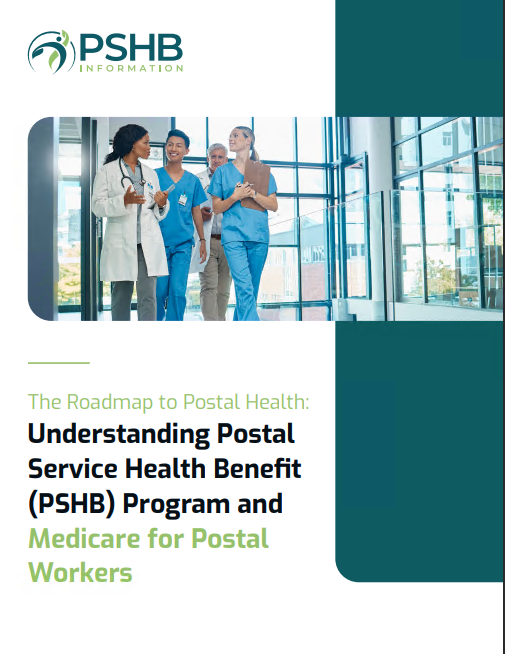Key Takeaways
-
When you’re enrolled in both Medicare and PSHB, Medicare usually becomes your primary payer, and that changes how your PSHB plan works for you.
-
These behind-the-scenes shifts can affect your cost-sharing responsibilities, provider billing, and drug coverage, especially if you don’t understand how coordination works.
What Happens When Medicare Becomes Primary
Once you turn 65 and enroll in Medicare Part A and Part B, Medicare typically becomes your primary coverage. This means it pays first for your eligible medical services, while your PSHB plan acts as secondary coverage, picking up some or all of the remaining costs depending on the service.
This switch in roles happens automatically. But if you don’t enroll in Medicare Part B when required by PSHB rules, your PSHB plan may pay as if you did. That can leave you with higher out-of-pocket expenses than you expected.
How PSHB Coordinates with Medicare
The Postal Service Health Benefits Program is designed to work with Medicare to reduce your healthcare costs, not duplicate them. When you have both:
-
Medicare pays first for covered services.
-
PSHB pays second, helping with deductibles, copayments, and coinsurance that Medicare doesn’t fully cover.
The result can be minimal or no out-of-pocket costs for many services—if you’re enrolled in both Part A and Part B.
Coordination Rules in Detail
When PSHB is the secondary payer, it uses what Medicare doesn’t cover as the basis for its payments. For example:
-
If Medicare covers 80% of a service, your PSHB plan may cover some or all of the remaining 20%.
-
If a service isn’t covered by Medicare but is covered by your PSHB plan, PSHB may step in as the primary payer for that specific item.
Part B Enrollment Is Not Optional for Many
Starting in 2025, certain Postal Service annuitants and their Medicare-eligible family members must enroll in Medicare Part B to maintain full PSHB benefits. This includes:
-
Annuitants who retire after January 1, 2025.
-
Family members of retirees who are Medicare-eligible.
There are exceptions, such as for those who retired on or before January 1, 2025, or those who qualify for waivers due to international residence or veteran benefits.
If you’re in one of the groups that must enroll and choose not to, you may lose key parts of your PSHB coverage.
Behind-the-Scenes: Drug Coverage Changes
When you enroll in Medicare and remain in a PSHB plan, your prescription coverage changes behind the scenes too. You are automatically enrolled in a Medicare Part D plan called an Employer Group Waiver Plan (EGWP), which is integrated with your PSHB benefits.
What the EGWP Means for You
-
Your PSHB plan works with this EGWP to coordinate drug costs.
-
The $2,000 out-of-pocket maximum now applies to your annual drug expenses under Part D.
-
Insulin is capped at $35 per month under the integrated drug coverage.
If you opt out of the EGWP, you risk losing all drug coverage from PSHB for the remainder of the calendar year, and re-enrollment is extremely limited.
Provider Networks and Billing
When Medicare becomes your primary, you’ll want to use providers who accept Medicare assignment. This ensures your claims are processed properly and reduces the risk of balance billing.
How Billing Works
-
Medicare pays its share directly to the provider.
-
The provider then sends the remaining balance to your PSHB plan.
-
You are responsible only for any amount left after both payers contribute, usually minimal.
This system works best when your provider understands how to bill both Medicare and PSHB. You should verify this with the provider before scheduling services.
Costs You May Still Have to Pay
Even with both Medicare and PSHB working together, some costs may remain depending on the service and your plan’s rules:
-
Monthly Part B premium: Standard premium is $185 in 2025.
-
Annual Part B deductible: $257 in 2025.
-
Costs from non-Medicare providers, if you use them.
-
Services not covered by either program.
However, many PSHB plans in 2025 reduce or even eliminate these costs for those enrolled in Medicare Part B. You may see waived deductibles, lower copays, and broader networks.
What If You Delay Part B Enrollment?
Delaying Medicare Part B enrollment can create coverage gaps or trigger penalties. PSHB rules now align with Medicare’s expectations, and if you don’t enroll in Part B when required, PSHB may pay as if you had Medicare.
This can lead to:
-
Higher out-of-pocket costs.
-
Claims processed at a lower reimbursement rate.
-
Reduced access to certain cost-saving PSHB benefits.
Unless you’re exempt, delaying Part B may harm your long-term coverage.
Understanding the Prescription Payment Plan
As of 2025, Medicare offers a new way to manage high prescription costs: the Medicare Prescription Payment Plan.
What It Offers
-
Instead of paying large out-of-pocket costs at the pharmacy, you can spread payments throughout the year.
-
Your PSHB-integrated EGWP coverage supports this plan.
If you’re eligible, this can ease budgeting for those with high drug costs.
Watch for Annual Notices of Change (ANOC)
Each fall, your PSHB plan will send an Annual Notice of Change detailing how benefits will adjust for the upcoming year.
Key items to look for include:
-
Any changes to coinsurance, copayments, or deductibles.
-
Updates to how your plan coordinates with Medicare.
-
Modifications to your drug coverage or EGWP enrollment.
Reading the ANOC carefully each year ensures you stay informed about any shifting benefits behind the scenes.
Special Enrollment Periods for PSHB and Medicare
You may qualify for a Special Enrollment Period (SEP) if your situation changes, allowing you to adjust your Medicare or PSHB coverage outside of Open Season.
Scenarios include:
-
Loss of employer-sponsored health insurance.
-
Moving out of your PSHB plan’s service area.
-
Becoming newly eligible for Medicare.
You typically have 60 days from the event to make changes, so it’s crucial to act promptly.
Open Season Is Still Your Best Planning Window
Each year, Open Season runs from November to December and gives you the opportunity to:
-
Switch PSHB plans.
-
Add or remove dependents.
-
Review how your current plan will coordinate with Medicare.
This is your best time to ensure your plan matches your needs if you’re enrolled in Medicare.
Why You Must Be Proactive
Although much of the coordination happens automatically, you need to:
-
Enroll in Medicare Part B when required.
-
Review your plan’s coordination rules each year.
-
Understand your provider’s billing practices.
-
Stay informed about drug coverage limits and changes.
If you assume your benefits haven’t changed, you may be surprised by bills or denied claims later.
Keep Your Coverage Working for You
Staying informed is the best way to get the most out of both Medicare and PSHB. The interaction between the two systems is designed to reduce your costs, but it requires:
-
Timely enrollment.
-
Annual plan review.
-
Clear understanding of how billing and drug benefits shift.
Missing one step can undo these advantages, especially after the 2025 rules take effect.
Get Expert Help Before You Decide
With so much happening behind the scenes, it’s easy to overlook the fine print. Make sure you don’t miss important shifts in your coverage by reviewing your options with a licensed agent listed on this website. They can help you:
-
Understand your obligations under 2025 PSHB rules.
-
Confirm Medicare Part B enrollment timing.
-
Evaluate plan features based on your Medicare status.
Take control now to avoid costly surprises later.







